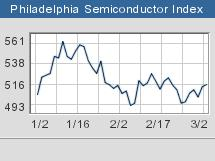
NEW YORK (CNN/Money) -
It hasn't been a good start to the season for the SOX.
Not the Boston Red Sox -- though Beantown residents still are smarting over the sight of A-Rod in pinstripes...heh heh.
I'm talking about the Philadelphia Semiconductor Index, known on Wall Street as the SOX.
After a strong year in 2003 (the SOX rose 76 percent), the positive momentum continued in the first trading days of 2004. But since Jan. 12, the index has fallen 8.5 percent. Shares of industry leader Intel have taken a particularly noticeable hit lately, sliding 13 percent.
The timing of the pullback is a bit curious because most of the eighteen chip and chip equipment companies in the SOX, including Intel, reported extremely strong fourth quarter results and gave upbeat guidance for the first quarter.
So what's next for semis?
Intel could spark a rally...
Several pros are betting on a resumption of the rally.
"We still see semis poised for a good move in the next nine months," said Michael Mara, manager of the Penn Street Advisors Sector Rotational Portfolio fund, a quantitative fund that uses computer screens to find attractively valued stocks with strong earnings momentum.
 |
|
| Semi stocks have begun to lose momentum after a strong 2003. |
Mara said he's taken advantage of the recent chip sell-off to buy more shares of Intel, National Semiconductor and Texas Instruments.
Investors will want to pay close attention to the mid-quarter update from Intel after the closing bell Thursday for more clues about the sector's health. Analysts expect sales of $8.3 billion for the quarter, a 23 percent increase from a year ago. Intel told Wall Street in January that it was anticipating sales to be in a range of $7.9 billion to $8.5 billion.
If Intel raises this guidance and gives an indication that consumer spending remains strong and that corporate spending is continuing to recover, then that could be a big catalyst for chip stocks.
| Recently in Tech Biz
|

|
|
|
|
But even if Intel's news is extremely good, it might not be the best bet. Some fund managers think that the recent dip in chips represents a good opportunity to get into lesser-known semiconductor names...especially those that have strong consumer electronics exposure.
Intel is undoubtedly a strong company, but its fortunes are still closely tied to the personal computer sector, with a majority of its sales coming from things like microprocessors and motherboards for desktops, notebooks and servers. So Intel will need to see a broader pickup in corporate information technology (IT) spending, in order to keep Wall Street happy.
...but other chip stocks may be better bets
A more savvy investment play may be to load up on companies like Linear Technology, Maxim Integrated Products and Analog Devices. They manufacture what are known as analog chips, which help convert analog signals (i.e. light and sound) into digital streams of information.
| �* based on calendar 2004 EPS estimates ** based on estimate revisions for current fiscal year during past three months | | �Source:��Thomson/Baseline |
|
These types of chips are crucial components of many popular consumer electronics gadgets.
"The proliferation of more digital devices like digital cameras leads to more need for analog chips. Those demand trends look pretty robust," said Mark Baribeau, manager of the Loomis Sayles Growth fund.
Baribeau said companies like Linear and Maxim are attractive. He also likes Xilinx, a maker of programmable logic chips that are used in many digital devices like cameras and MP3 players, and Texas Instruments, which makes digital signal processors used in cell phones and digital light processor chips for flat-screen TVs.
Of course, valuation is a concern for chip investors right now. Most chip companies with decent consumer exposure are trading at a range of 35 to 40 times calendar earnings estimates for 2004 while Intel's P/E is just 24.
Still, Jaye Morency, a portfolio manager with mutual fund firm D.L. Babson, said she also likes the consumer-oriented chip companies more than Intel and its main rival Advanced Micro Devices.
Morency said the top chip stocks in various D.L. Babson funds are Analog Devices, Maxim, Linear, Xilinx and Altera (another maker of programmable logic chips).
"We will see a differentiation between chip companies that are exposed to pure IT spending and those exposed to consumer and analog. IT spending is not going to be a barn-burner," Morency said.
To that end, 2004 earnings estimates for the analog companies have climbed higher in recent months. In addition, the long-term annual earnings growth rate estimates for these companies range from about 20 percent to 25 percent while Intel's projected annual growth rate is 16 percent.
So even though Intel's mid-quarter update will snare all the headlines this week, just remember that the semiconductor sector doesn't begin and end with Intel.
Sign up to receive the Tech Investor column by e-mail.
Plus, see more tech commentary and get the latest tech news.

|

